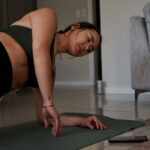Your hip adductors, a bunch of muscle tissues typically regarded as the interior thighs, usually don’t get a lot consideration—but when they’re tight or weak, it could actually have cascading results on how your physique strikes. The whole lot you could learn about coaching your adductors (together with the 5 greatest hip adductor workouts to attempt), forward.
What are your hip adductors?
Your hip adductors are a bunch of muscle tissues on the interior thigh, typically known as the groin muscle tissues or interior thighs. “The hip adductors assist stabilize the pelvis, carry the leg towards the midline of the physique, and carry out actions corresponding to crossing your legs,” says Schuyler Archambault, DPT, CSCS, bodily therapist, energy coach, and proprietor of Arch Bodily Remedy and Health. They act reverse the hip abductors, that are on the skin of your hip and transfer your leg away out of your physique, out to the facet (abduction versus adduction is difficult, we all know).
The main muscle tissues2 within the adductor group embrace the adductor longus, adductor brevis, adductor magnus, gracilis, and pectineus. Each stretches from the pelvis all the way down to the within of your femur (thigh bone)—or, within the case of the gracilis, all the way in which all the way down to your tibia (shin bone). This group of muscle tissues isn’t solely answerable for hip adduction but additionally works to rotate your leg and lengthen or flex your hip, relying on the muscle and place you’re in.
Why is it vital to strengthen your hip adductors?
Should you had been round for a few of the early aughts’ poisonous food regimen tradition, it’s possible you’ll consider the interior thighs as an arrogance muscle, however they’re removed from it—your hip adductors have an vital job to do. The important thing cause folks want to coach their hip adductors is due to their function in stabilizing the pelvis, Archambault says. That’s primarily your pelvis’s capability to keep up a managed and balanced place when you’re transferring or bearing weight (suppose: not tilting to the facet once you choose up one foot to take a step ahead).
With that in thoughts, your hip adductors assist you to do issues like keep steadiness, execute lateral actions, and stroll and run, says Stacy Orsborn, CPT, licensed private coach and co-founder of Victress MVMT. They assist you to lower throughout the sphere or courtroom when enjoying soccer or basketball, skate down an ice rink, and supply dynamic stability once you bounce as much as hit an overhead smash on the pickleball courtroom.
“When these muscle tissues are weak, it could actually result in instability or overcompensation in different areas, just like the hips or knees—which isn’t good, particularly as you age,” Orsborn says. For instance, having weak or tight adductors can contribute to knee3 or again ache4.
That’s proper, it’s not simply sufficient to have sturdy hip adductors; they should have an ample vary of movement, too. “Mobility and suppleness within the adductors are equally vital as a result of tightness can limit how freely your hips transfer, growing the chance of pressure, harm, and discomfort in on a regular basis actions and exercises,” Orsborn says. Fortunately, many hip-adduction strengthening workouts (extra on these beneath) assist drill your mobility, too.
There’s an vital caveat, although: Extra adductor energy isn’t all the time a superb factor. Actually, it’s key to have balanced in each your adductors and abductors to maintain your pelvis steady and hips and knees aligned. In case you have far more adductor energy, for instance, it could actually trigger your knees to break down inward6 when squatting, working, or touchdown after a bounce, which may doubtlessly result in points like ACL tears7.
Your hip adductors assist you to do issues like keep steadiness, execute lateral actions, and stroll and run.
Learn how to work your hip adductors
Archambault recommends beginning with strikes that really isolate the adductors—for instance, the seated hip adductor machine within the health club, a cable machine hip adduction, or the Copenhagen plank (proven beneath). “After I need to concentrate on a hip adductor train and a shopper hasn’t had publicity to those actions prior, I prefer to have them carry out an train that isolates this muscle group slightly than working with a number of different muscle teams,” Archambault says. This helps guarantee the appropriate muscle tissues are kicking into gear.
Simply because hip adductor energy is vital doesn’t imply you could go wild with including focused workouts to your routine; bear in mind, balanced energy is the aim. Archambault recommends including one or two hip adduction actions into your exercise routine two to 3 occasions per week. “Twice per week is an efficient start line,” Orsborn agrees.
Orsborn suggests incorporating each adductor mobility workouts (just like the adductor rock again) or mild activation work (for instance, standing squeezes or side-lying actions) into your warmup, then including compound, strength-focused actions into the primary portion of your exercise for the perfect outcomes. “For flexibility, I’d advocate static stretches or mobility work throughout your cooldown, which helps with vary of movement and secure restoration,” she says.
Finest hip adduction workouts
These hip adduction workouts will assist you to faucet into the mighty muscle tissues in your interior thighs, so you possibly can construct pelvic stability and keep prepared for no matter your every day life, exercise, or favourite sport has in retailer. You might acknowledge a few of them from barre or Pilates exercises, which are likely to put numerous emphasis on strengthening muscle tissues throughout the hip joint.
1. Standing adductor ball squeeze (isometric)
This can be a easy but efficient method to interact your interior thighs whereas additionally activating the core, making it good for constructing stability there, too, Orsborn says. You need to use a foam curler, small train ball, or a yoga block, relying on what’s out there.
- Stand along with your ft shoulder-width aside.
- Place a small train ball or foam curler between your thighs, simply above your knees.
- Squeeze the ball or curler firmly for 10-15 seconds, then launch.
- That’s 1 rep. Do 3 units.
2. Aspect-lying leg raise (adductor-focused)
“These are nice in the event you’re engaged on hip mobility and energy,” Orsborn says. One small 2014 examine8 revealed within the Journal of Sport Rehabilitation examined a sequence of adductor strikes on school college students and located that the side-lying leg raise produced extra peak and common activation than any of the opposite workouts, together with ball squeezes, rotational squats, sumo squats, and standing adduction on a Swiss ball.
- Lie in your proper facet with the appropriate leg prolonged straight and your torso propped up in your proper elbow.
- Bend your left leg and place the foot in entrance of the appropriate thigh so your toes face away out of your proper leg. Have interaction your core and take into consideration lifting your proper waist away from the ground slightly than collapsing down into it.
- Along with your proper leg prolonged and the foot flexed, raise your leg up just a few inches, partaking the interior thigh.
- Decrease your proper leg with management.
- Do 3 units of 10-15 reps on all sides.
3. Copenhagen plank
A favourite of each Archambault and Orsborn, the Copenhagen plank is nice for strengthening your core and adductors. This builds stability that interprets into on a regular basis actions, Orsborn says. It’s fairly powerful, although. If the beneath variation is just too tough, attempt modifying by bending your backside knee right into a modified facet plank and permitting it to stay on the ground and assist a few of your weight when you plank. To make it even tougher, you possibly can raise and decrease your backside leg, as proven within the video.
- Place your self in a facet plank in your proper elbow along with your left leg elevated on a field or bench.
- Have interaction your core and raise your hips and backside leg, utilizing your adductors to keep up the place. Strive to not let your self tilt backward or ahead.
- Maintain for 15-30 seconds, then repeat on the opposite facet.
4. Sumo squat
Sumo squats permit you to hit each your interior thighs and glutes whereas selling higher hip mobility, Orsborn says. It’s a compound motion that ought to match nicely into the energy part of your routine.
- Stand along with your ft large, toes pointed barely outward.
- Bend your knees to decrease right into a squat, conserving your chest tall and knees aligned along with your toes. (In case your knees are going far previous your toes, you need to step your ft wider.)
- Pause when your thighs are parallel to the ground.
- Press your ft into the ground to straighten your legs and return to standing whereas squeezing your interior thighs. That’s 1 rep.
- Do 3 units of 10-12 reps.
5. Cossack squat
Cossack squats work each your adductors and abductors, making them an awesome choose for all-around sturdy and wholesome hips. “These are greatest for engaged on each leg energy and suppleness,” Orsborn says. “They open up the hips and problem your steadiness in a practical method.”
- Begin standing along with your ft large, toes barely turned out.
- Shift your weight to the appropriate facet, bending the appropriate knee deeply whereas conserving the opposite leg prolonged.
- Sit your hips backward and decrease so far as attainable right into a squat in your proper leg, rolling onto your left heel and permitting your left toes to level up towards the ceiling.
- Push by the bent leg to return to standing, then repeat on the opposite facet. That’s 1 rep.
- Do 3 units of 10-12 reps.










